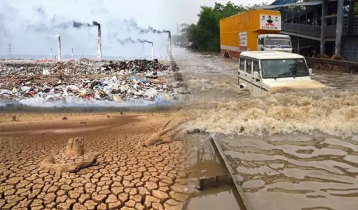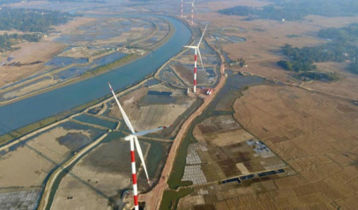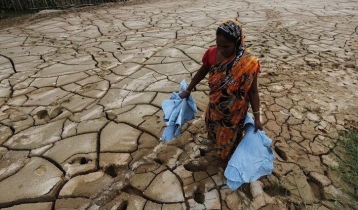Biodiversity silent driving force of economy remains neglected
Hasan Mahmud || risingbd.com

Photo Source: greenly
There is an ongoing decline in biodiversity, just as there is a simultaneous loss of biodiversity for many other living beings. One of the main reasons for this decline is climate change. Biodiversity plays an essential role in the global economy. But, this silent driving force of the economy remains neglected in most of the countries.
Global biodiversity loss inflicts considerable economic damage measurable in monetary terms, severely affecting agriculture, tourism, and natural resource industries. Immediate impacts are evident, as Sub-Saharan Africa suffers approximately $2.1 billion in agricultural losses annually. Medium-term effects are seen in Southeast Asia, where deteriorating coral reefs have caused an estimated $3.7 billion decline in tourism revenue over recent years. Long-term projections in North America indicate that habitat degradation could reduce natural resource yields by over $4.5 billion in the coming decades. Business leaders and policy makers must prioritize sustainable environmental investments to counteract these quantifiable financial threats and ensure economic resilience.
Biodiversity refers to the genetic, species, and ecological (ecosystem) diversity found among all plants, animals, and microorganisms inhabiting the earth's soil, water, and air. The basic needs of humans—such as food, clothing, shelter, and medical care—are sourced from a diverse array of plants and animals. The greater the diversity of species, the more stable and balanced the ecosystem becomes. A rich biodiversity is essential for sustenance, shelter, and overall well-being.
Over the past 50 years, unprecedented changes in land and ocean use have been identified as the primary reasons for the loss of biodiversity and ecosystems. Human activities have altered three-quarters of terrestrial environments and nearly 66 percent of marine environments. For example, nearly half of the land in the United States that was once European settlements has been converted into agricultural land. In these transformed areas, yields are 70 percent lower than the national average. In efforts to increase production, a significant amount of biodiversity is being destroyed. However, it is time to consider the economic loss a country incurs by destroying biodiversity. Until we understand the importance of biodiversity to the economy, the issue will not hold significant weight for us.
The extent of economic loss due to biodiversity loss in Bangladesh has yet to be determined. Although there have been several initiatives by the government, they have not met with success. The same scenario is observed in most countries around the world. Yet, some economic activities, while seemingly beneficial to humans, are causing significant damage to biodiversity, leading to various crises. These harmful activities are linked to essential sectors such as agriculture, energy, and fisheries. According to a recent report by the Intergovernmental Science-Policy Platform on Biodiversity and Ecosystem Services (IPBES), activities aimed at short-term growth in these sectors are destroying biodiversity and escalating crises related to nature, climate, and human health. As a result, the global economy faces a loss of $25 trillion annually.
The report warns that a lack of coordination in addressing crises is exacerbating financial losses. Biodiversity loss, climate change, water scarcity, food insecurity, and health risks are still being tackled separately. This not only increases the problems but also raises costs. For three years, 165 scientists have worked on this report, which indicates that industry owners are not considering the environmental and social damages incurred by their business activities. The overlooked costs range from $10 trillion to $25 trillion, which constitutes a quarter of the global GDP.
The issue of biodiversity conservation gained significant attention during an international summit held in Brazil in 1992. The total number of species on Earth remains unknown today, and it is uncertain whether it will ever be known. It is estimated that between 5 million and 30 million different species inhabit the planet, with approximately 1.5 million species identified so far. Among these are 751,000 insect species, 281,000 other animal species, 250,000 flowering plants, 68,000 fungi, 26,900 mosses, 30,000 protists, 4,800 bacteria, and 1,000 viruses, among others. However, due to various reckless human activities, an average of 27,000 species is being destroyed each year. Scientists warn that if this continues, a quarter of all species on Earth could be wiped out by 2050.
Important Factors to Consider in Assessing the Contribution of Biodiversity
Before determining the economic contribution of biodiversity, we must identify the essential sectors from which we receive direct and indirect financial support. Beyond the sectors we can identify, there are countless others that quietly contribute to the national economy through biodiversity.
The essence of biodiversity conservation lies in providing a safe environment for all living beings. Biodiversity is particularly reliant on water, soil, and forest resources. Life is unsustainable without water. All types of aquatic life, including fish, inhabit surface water. Water is a crucial nutrient, serving as the habitat for fish, which provide 20% of protein for 300 million people. When water becomes polluted, it means the habitats of aquatic life, including fish, are compromised. This is because a decrease in oxygen levels in polluted water makes it impossible for living beings to survive. For example, the Buriganga River, which suffers from pollution, has no fish or aquatic animals.
Rainwater fills surface water bodies, with some of it seeping underground, providing people with drinking water. When water bodies are filled in, groundwater cannot replenish. As a result, the water table is dropping each year. During the dry season, many districts in the country face a drinking water crisis. All people on Earth depend on water, air, and food. In terms of livelihoods, approximately 2.6 billion people are engaged in fishing and agricultural production processes globally. About 80% of what we eat comes from agricultural products.
Another major area of biodiversity is forests. Eighty percent of terrestrial species live in forests. Among 8,300 species of animals, 8% are extinct, and 22% are at risk of extinction. The livelihoods of nearly 1.6 billion people, including 70 million indigenous people, depend directly and indirectly on forest resources. Moreover, considering the oxygen produced by trees, all people on Earth depend on trees and forest resources. Trees also play an invaluable role in combating negative climate change. Of the 80,000 species of trees in the world, only 1% have been researched for their significant uses. Additionally, approximately 80% of people living in rural areas today use herbal medicines, which are primarily sourced from forest resources.
Around 25% of the global population is estimated to work in agriculture. Estimating the economic value of biodiversity in agriculture and through the use of wild species for food is both challenging and controversial. Horticultural plant biodiversity can be highly profitable and provides opportunities for employment. In the UK, growth of ornamental plants was worth £1.7 billion in 2023.
Biodiversity is a source of food, medication, and materials used in industry. It plays an important role in industry. It acts as a source of natural resources, materials, and products that are sold, consumed, or used in manufacturing. Recreation and tourism are also examples of human economic activities that rely on these benefits. In 2018, the WWF Living Planet Report argues that the whole global economy of US$125 trillion ultimately relies on nature.
The benefits of biodiversity are often evaluated in an anthropocentric way and the inherent value of biodiversity, outside of its benefits to humanity, has been debated by economists. Despite these benefits, economic activities often result in harm to biodiversity, such as through deforestation.
The majority of species have yet to be evaluated for their current or future economic importance. Raw materials, pharmaceuticals and drug production all directly and indirectly depend upon biodiversity.
Impact of economic activity on biodiversity
Even though biodiversity supports the economy, economic activity frequently degrades biodiversity, and since it offers financial incentives, it is frequently prioritized over conservation and restoration efforts. This adds to the worldwide decline in biodiversity, which has several causes, including overexploitation, pollution, habitat loss, and changes in land use.
Boston Consulting Group (BCG) estimates that economic activities related to agriculture, infrastructure, fashion, and energy account for over 90% of the anthropogenic drivers of biodiversity loss. Furthermore, the IUCN estimates that mining, energy, infrastructure, and agriculture affect 79% of vulnerable species.
It was projected that the loss of terrestrial biodiversity between 2000 and 2010 cost the world economy $500 billion. Long-term risks to society and the economy include an increased likelihood of pandemics, floods, and droughts due to ongoing biodiversity loss and environmental degradation.
What Experts Are Saying: What We Should Do and What Solutions Are Available
The Bay of Bengal is a blessing for Bangladesh. However, we are carelessly destroying this resource and missing out on the benefits of the marine economy. Biodiversity is crucial to the marine economy, which can be said to be the lifeblood of Bangladesh's national economy. Unfortunately, various factors are putting the marine life and ecosystem of the Bay of Bengal at risk.
Instead of prioritizing the extraction of marine energy, we should focus on renewable energy sources such as offshore windmills. The government needs to pay special attention to developing wind energy management as part of its economic management expansion. Renewable energy is both cost-effective and sustainable, providing widespread and long-lasting benefits to the economy. Numerous organizations and institutions are fighting to protect marine habitats and wildlife. It is essential for everyone to be aware of marine life, as a significant part of the economy is tied to the marine sector.
To protect biodiversity, all water bodies in the country must be safeguarded from encroachment and pollution. Necessary measures, including dredging, must be taken to enhance the water retention capacity of rivers and other water bodies. The use of all natural resources, including gas, electricity, and fuel, must be regulated, as water is used in their production. The use of tissue and paper should be limited.
The sea, seabed, and coastal areas have become the largest zones for privatization. The 1982 United Nations Convention on the Law of the Sea granted coastal countries exclusive economic zones extending 200 nautical miles from their shores. As a result, one-third of the world's marine areas have been transformed into state-owned resources. This has primarily benefited colonial powers connected to remote island regions. France and the United States each received over 11 million square kilometers of marine area, while the United Kingdom obtained 6.8 million square kilometers, which is 27 times more than its land area.
Governments in various countries have allowed private organizations access to marine resources. They have granted or sold private property rights in the sea. This has devastated the marine environment and reduced fish populations. Wastewater, chemicals, and plastics are being pumped into the sea. The extraction of mineral resources and tourism is destroying wetlands, mangroves, and other coastal ecosystems.
Dr. Mohammad Taj Uddin, Dean of the Faculty of Agricultural Economics & Rural Sociology of Bangladesh Agricultural University, said climate change and human activities pose a significant threat to biodiversity in Bangladesh, similar to the situation worldwide. The adverse effects of climate change on biodiversity are evident in the vast areas of the Sundarbans coastal region of Bangladesh. Illegal deforestation and wildlife extermination, riverbank encroachment, pollution, deforestation, hill cutting, poverty, unplanned urbanization, water and air pollution, industrial waste, excessive use of harmful pesticides, and over-extraction of groundwater have all contributed to the current environmental crisis in Bangladesh.
In light of this situation, urgent steps must be taken to conserve biodiversity in geological, aquatic, and marine environments. Dredging must be conducted to increase the navigability of rivers, and effective measures should be implemented for the proper execution of water agreements with India. Reserved forest areas should not be allocated for development projects. Development projects must be undertaken while maintaining a balance between development and biodiversity. It is essential to prevent indiscriminate deforestation and ensure proper management of protected forests. The public must be educated and made aware that forests and wildlife are integral parts of our lives.
Professor Rashed Al Mahmood Titumir, Chairman of the Development Studies Department at Dhaka University, stated that past biodiversity targets have not been met. There is a need for several effective accountability mechanisms. First, there must be measurable quantitative targets. All stakeholders in society should know what percentage of land will be restored or how much pollution the government intends to reduce. Monitoring must include target-based milestones. Second, the state's understanding of life and ecosystems remains flawed, and there are significant gaps in the data. The quality of data must be improved. Ultimately, a proper accountability system is necessary. If world leaders wish to fulfill their commitments, this is crucial.
The writer is a senior journalist
Dhaka/Mukul



































